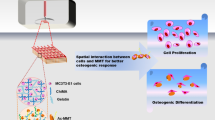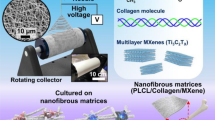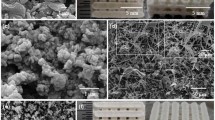Abstract
Poly(ε-caprolactone) (PCL) scaffolds with interconnecting pore were fabricated by solvent casting and particulate leaching. Surface modification of a PCL scaffold to improve hydrophilicity was performed via layer-by-layer (LbL) deposition of poly(diallyldimethylammonium chloride) (PDADMAC) and poly(sodium 4-styrenesulfonate) (PSS) and evaluated using aniline blue staining and X-ray photoelectron spectroscopy (XPS). Aniline blue staining was performed to determine the extent of PDADMAC/PSS deposition on the PCL dual-leached scaffold through the inner pores. Peaks attributed to the N 1s orbitals of PDADMAC and the S 2p orbitals of PSS appeared in the XPS spectra of the PCL scaffold. By using LbL deposition, osteopontin (OPN) was immobilized on the top surface. In vitro biological evaluation of the cytotoxicity, cell proliferation, alkaline phosphatase (ALP) activity, and mineralization were performed. The results showed that the OPN-immobilized PCL scaffold was nontoxic and did not promote cell proliferation, but it highly enhanced the osteogenic differentiation of MC3T3-E1 cells including ALP activity and mineral deposition compared to the control. This study revealed that LbL deposition on a PCL scaffold surface is sufficient to enable the local delivery of OPN to improve cell interactions with scaffolds.










Similar content being viewed by others
References
Nemati Hayati A, Hosseinalipour SM, Rezaie HR, Shokrgozar MA (2012) Characterization of poly(3-hydroxybutyrate)/nano-hydroxyapatite composite scaffolds fabricated without the use of organic solvents for bone tissue engineering applications. Mater Sci Eng C 32(3):416–422. https://doi.org/10.1016/j.msec.2011.11.013
Xia P, Zhang K, Yan S, Li G, Yin J (2021) Biomimetic, biodegradable, and osteoinductive Microgels with open porous structure and excellent injectability for construction of microtissues for bone tissue engineering. Chem Eng J. https://doi.org/10.1016/j.cej.2021.128714
Ventura RD, Padalhin AR, Park CM, Lee BT (2019) Enhanced decellularization technique of porcine dermal ECM for tissue engineering applications. Mater Sci Eng C 104:109841. https://doi.org/10.1016/j.msec.2019.109841
Qu H (2020) Additive manufacturing for bone tissue engineering scaffolds. Mater Today Commun 24:101024. https://doi.org/10.1016/j.mtcomm.2020.101024
Ghassemi T, Shahroodi A, Ebrahimzadeh MH, Mousavian A, Movaffagh J, Moradi A (2018) Current concepts in scaffolding for bone tissue engineering. Arch Bone Jt Surg 6(2):90–99
Asadi N, Del Bakhshayesh AR, Davaran S, Akbarzadeh A (2020) Common biocompatible polymeric materials for tissue engineering and regenerative medicine. Mater Chem Phys 242:122528. https://doi.org/10.1016/j.matchemphys.2019.122528
Mandic M, Spasic J, Ponjavic M, Nikolic MS, Cosovic VR, O’Connor KE, Nikodinovic-Runic J, Djokic L, Jeremic S (2019) Biodegradation of poly(ε-caprolactone) (PCL) and medium chain length polyhydroxyalkanoate (mcl-PHA) using whole cells and cell free protein preparations of Pseudomonas and Streptomyces strains grown on waste cooking oil. Polym Degrad Stab 162:160–168. https://doi.org/10.1016/j.polymdegradstab.2019.02.012
Pogorielov M, Hapchenko A, Deineka V, Rogulska L, Oleshko O, Vodseďálková K, Berezkinová L, Vysloužilová L, Klápšťová A, Erben J (2018) In vitro degradation and in vivo toxicity of NanoMatrix3D® polycaprolactone and poly(lactic acid) nanofibrous scaffolds. J Biomed Mater Res Part A 106(8):2200–2212. https://doi.org/10.1002/jbm.a.36427
Siddiqui N, Asawa S, Birru B, Baadhe R, Rao S (2018) PCL-based composite scaffold matrices for tissue engineering applications. Mol Biotechnol 60(7):506–532. https://doi.org/10.1007/s12033-018-0084-5
Faezeh G, Semnani D, Khorasani SN, Varshosaz J, Khalili S, Mohammadi S, Kaviannasab E (2020) Polycaprolactone-gelatin membranes in controlled drug delivery of 5-Fluorouracil. Polym Sci Ser A 62(6):636–647. https://doi.org/10.1134/S0965545X20330020
Raina N, Rani R, Khan A, Nagpal K, Gupta M (2020) Interpenetrating polymer network as a pioneer drug delivery system: a review. Polym Bull 77(9):5027–5050. https://doi.org/10.1007/s00289-019-02996-5
Sarvari R, Massoumi B, Zareh A, Beygi-Khosrowshahi Y, Agbolaghi S (2020) Porous conductive and biocompatible scaffolds on the basis of polycaprolactone and polythiophene for scaffolding. Polym Bull 77(4):1829–1846. https://doi.org/10.1007/s00289-019-02732-z
Cacciotti I, Calderone M, Bianco A (2013) Tailoring the properties of electrospun PHBV mats: co-solution blending and selective removal of PEO. Eur Polymer J 49(10):3210–3222. https://doi.org/10.1016/j.eurpolymj.2013.06.024
Yu L, Dean K, Li L (2006) Polymer blends and composites from renewable resources. Prog Polym Sci 31(6):576–602. https://doi.org/10.1016/j.progpolymsci.2006.03.002
Zhang W, Ullah I, Shi L, Zhang Y, Ou H, Zhou J, Ullah MW, Zhang X, Li W (2019) Fabrication and characterization of porous polycaprolactone scaffold via extrusion-based cryogenic 3D printing for tissue engineering. Mater Des 180:107946. https://doi.org/10.1016/j.matdes.2019.107946
Zhang K, Wang Y, Jiang J, Wang X, Hou J, Sun S, Li Q (2019) Fabrication of highly interconnected porous poly(ɛ-caprolactone) scaffolds with supercritical CO2 foaming and polymer leaching. J Mater Sci 54(6):5112–5126. https://doi.org/10.1007/s10853-018-3166-7
Xiao X, Jiang X, Yang S, Lu Z, Niu C, Xu Y, Huang Z, Kang YJ, Feng L (2021) Solvent evaporation induced fabrication of porous polycaprolactone scaffold via low-temperature 3D printing for regeneration medicine researches. Polymer 217:123436. https://doi.org/10.1016/j.polymer.2021.123436
Scaffaro R, Sutera F, Lopresti F (2017) Using Taguchi method for the optimization of processing variables to prepare porous scaffolds by combined melt mixing/particulate leaching. Mater Des 131:334–342. https://doi.org/10.1016/j.matdes.2017.06.025
Obasi HC, Chaudhry AA, Ijaz K, Akhtar H, Malik MH (2018) Development of biocomposites from coir fibre and poly (caprolactone) by solvent casting technique. Polym Bull 75(5):1775–1787. https://doi.org/10.1007/s00289-017-2122-z
Klimek K, Ginalska G (2020) Proteins and peptides as important modifiers of the polymer scaffolds for tissue engineering applications: a review. Polymers. https://doi.org/10.3390/polym12040844
Sangsanoh P, Ekapakul N, Israsena N, Suwantong O, Supaphol P (2018) Enhancement of biocompatibility on aligned electrospun poly(3-hydroxybutyrate) scaffold immobilized with laminin towards murine neuroblastoma Neuro2a cell line and rat brain-derived neural stem cells (mNSCs). Polym Adv Technol 29(7):2050–2063. https://doi.org/10.1002/pat.4313
Shende P, Patil A, Prabhakar B (2020) Layer-by-layer technique for enhancing physicochemical properties of actives. J Drug Deliv Sci Technol 56:101519. https://doi.org/10.1016/j.jddst.2020.101519
Dubas ST, Kittitheeranun P, Rangkupan R, Sanchavanakit N, Potiyaraj P (2009) Coating of polyelectrolyte multilayer thin films on nanofibrous scaffolds to improve cell adhesion. J Appl Polym Sci 114(3):1574–1579. https://doi.org/10.1002/app.30690
Michna A (2017) Macroion adsorption: electrokinetic and optical methods. Adv Coll Interface Sci 250:95–131. https://doi.org/10.1016/j.cis.2017.09.004
Zhu M, He H, Meng Q, Zhu Y, Ye X, Xu N, Yu J (2020) Osteopontin sequence modified mesoporous calcium silicate scaffolds to promote angiogenesis in bone tissue regeneration. J Mater Chem B. https://doi.org/10.1039/D0TB00527D
Carvalho MS, Poundarik AA, Cabral JMS, da Silva CL, Vashishth D (2018) Biomimetic matrices for rapidly forming mineralized bone tissue based on stem cell-mediated osteogenesis. Sci Rep 8(1):14388. https://doi.org/10.1038/s41598-018-32794-4
França CM, Thrivikraman G, Athirasala A, Tahayeri A, Gower LB, Bertassoni LE (2019) The influence of osteopontin-guided collagen intrafibrillar mineralization on pericyte differentiation and vascularization of engineered bone scaffolds. J Biomed Mater Res B Appl Biomater 107(5):1522–1532. https://doi.org/10.1002/jbm.b.34244
Thadavirul N, Pavasant P, Supaphol P (2017) Fabrication and evaluation of polycaprolactone–poly(hydroxybutyrate) or poly(3-hydroxybutyrate-co-3-hydroxyvalerate) dual-leached porous scaffolds for bone tissue engineering applications. Macromol Mater Eng 302(3):1600289. https://doi.org/10.1002/mame.201600289
Thadavirul N, Pavasant P, Supaphol P (2014) Improvement of dual-leached polycaprolactone porous scaffolds by incorporating with hydroxyapatite for bone tissue regeneration. J Biomater Sci Polym Ed 25(17):1986–2008. https://doi.org/10.1080/09205063.2014.966800
Saikaew R, Marsal P, Grenier B, Dubas ST (2018) Temperature controlled loading and release of curcumin in polyelectrolyte multilayers thin films. Mater Lett 215:38–41. https://doi.org/10.1016/j.matlet.2017.12.010
Xiao S, Xu P, Peng Q, Chen J, Huang J, Wang F, Noor N (2017) Layer-by-layer assembly of polyelectrolyte multilayer onto PET fabric for highly tunable dyeing with water soluble dyestuffs. Polymers. https://doi.org/10.3390/polym9120735
Khampieng T, Yamassatien V, Ekabutr P, Pavasant P, Supaphol P (2018) Protein adsorption and cell behaviors on polycaprolactone film: the effect of surface topography. Adv Polym Technol 37(6):2030–2042. https://doi.org/10.1002/adv.21861
Greczynski G, Hultman L (2020) X-ray photoelectron spectroscopy: towards reliable binding energy referencing. Prog Mater Sci 107:100591. https://doi.org/10.1016/j.pmatsci.2019.100591
Wang D, Christensen K, Chawla K, Xiao G, Krebsbach PH, Franceschi RT (1999) Isolation and characterization of MC3T3-E1 preosteoblast subclones with distinct in vitro and in vivo differentiation/mineralization potential. J Bone Miner Res 14(6):893–903. https://doi.org/10.1359/jbmr.1999.14.6.893
Boonmak N, Niyompanich J, Chuysinuan P, Niamlang P, Ekabutr P, Supaphol P (2018) Preparation of mangosteen extract-loaded poly(vinyl acetate) for use as an antibacterial spray-on dressing. J Drug Deliv Sci Technol 46:322–329. https://doi.org/10.1016/j.jddst.2018.05.033
Sha L, Huang L, Luo X, Bao J, Gao L, Pan Q, Guo M, Zheng F, Wang H (2017) Long non-coding RNA LINC00261 inhibits cell growth and migration in endometriosis. J Obstet Gynaecol Res 43(10):1563–1569. https://doi.org/10.1111/jog.13427
Ryseff JK, Bohn AA (2012) Detection of alkaline phosphatase in canine cells previously stained with Wright-Giemsa and its utility in differentiating osteosarcoma from other mesenchymal tumors. Vet Clinic Pathol 41(3):391–395. https://doi.org/10.1111/j.1939-165X.2012.00445.x
Ghavidel Mehr N, Hoemann CD, Favis BD (2015) Chitosan surface modification of fully interconnected 3D porous poly(ε-caprolactone) by the LbL approach. Polymer 64:112–121. https://doi.org/10.1016/j.polymer.2015.03.025
Su B, Wang T, Wang Z, Gao X, Gao C (2012) Preparation and performance of dynamic layer-by-layer PDADMAC/PSS nanofiltration membrane. J Membr Sci 423–424:324–331. https://doi.org/10.1016/j.memsci.2012.08.041
Meng J, Yang G, Liu L, Song Y, Jiang L, Wang S (2017) Cell adhesive spectra along surface wettability gradient from superhydrophilicity to superhydrophobicity. Science China Chem 60(5):614–620. https://doi.org/10.1007/s11426-016-9031-8
Acknowledgements
This research was supported by (a) Grant for International Research Integration: Research Pyramid, Ratchadapiseksomphot Endowment Fund (GCURP_58_02_63_01) of Chulalongkorn University and (b) PETROMAT: Center of Excellence on Petrochemical and Materials Technology, Thailand.
Author information
Authors and Affiliations
Corresponding author
Ethics declarations
Conflicts of interest
The authors declare no conflicts of interest regarding the publication of this paper.
Additional information
Publisher's Note
Springer Nature remains neutral with regard to jurisdictional claims in published maps and institutional affiliations.
Rights and permissions
About this article
Cite this article
Niyompanich, J., Chuysinuan, P., Pavasant, P. et al. Immobilization of osteopontin on poly(ε-caprolactone) scaffolds by polyelectrolyte multilayer deposition to improve the osteogenic differentiation of MC3T3-E1 cells. Polym. Bull. 79, 4667–4684 (2022). https://doi.org/10.1007/s00289-021-03719-5
Received:
Revised:
Accepted:
Published:
Issue Date:
DOI: https://doi.org/10.1007/s00289-021-03719-5




